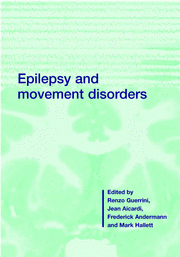Book contents
- Frontmatter
- Contents
- List of contributors
- Preface and overview
- 1 Epilepsies as channelopathies
- 2 Epilepsy and movement disorders in the GABAA receptor β3 subunit knockout mouse: model of Angelman syndrome
- 3 Genetic reflex epilepsy from chicken to man: relations between genetic reflex epilepsy and movement disorders
- 4 Functional MRI of the motor cortex
- 5 Neuromagnetic methods and transcranial magnetic stimulation for testing sensorimotor cortex excitability
- 6 Motor dysfunction resulting from epileptic activity involving the sensorimotor cortex
- 7 Nocturnal frontal lobe epilepsy
- 8 Motor cortex hyperexcitability in dystonia
- 9 The paroxysmal dyskinesias
- 10 Normal startle and startle-induced epileptic seizures
- 11 Hyperekplexia: genetics and culture-bound stimulus-induced disorders
- 12 Myoclonus and epilepsy
- 13 The spectrum of epilepsy and movement disorders in EPC
- 14 Seizures, myoclonus and cerebellar dysfunction in progressive myoclonus epilepsies
- 15 Opercular epilepsies with oromotor dysfunction
- 16 Facial seizures associated with brainstem and cerebellar lesions
- 17 Neonatal movement disorders: epileptic or non-epileptic
- 18 Epileptic and non-epileptic periodic motor phenomena in children with encephalopathy
- 19 Epileptic stereotypies in children
- 20 Non-epileptic paroxysmal eye movements
- 21 Shuddering and benign myoclonus of early infancy
- 22 Epilepsy and cerebral palsy
- 23 Sydenham chorea
- 24 Alternating hemiplegia of childhood
- 25 Motor attacks in Sturge–Weber syndrome
- 26 Syndromes with epilepsy and paroxysmal dyskinesia
- 27 Epilepsy genes: the search grows longer
- 28 Genetics of the overlap between epilepsy and movement disorders
- 29 Seizures and movement disorders precipitated by drugs
- 30 Steroid responsive motor disorders associated with epilepsy
- 31 Drugs for epilepsy and movement disorders
- Index
- Plate section
12 - Myoclonus and epilepsy
Published online by Cambridge University Press: 03 May 2010
- Frontmatter
- Contents
- List of contributors
- Preface and overview
- 1 Epilepsies as channelopathies
- 2 Epilepsy and movement disorders in the GABAA receptor β3 subunit knockout mouse: model of Angelman syndrome
- 3 Genetic reflex epilepsy from chicken to man: relations between genetic reflex epilepsy and movement disorders
- 4 Functional MRI of the motor cortex
- 5 Neuromagnetic methods and transcranial magnetic stimulation for testing sensorimotor cortex excitability
- 6 Motor dysfunction resulting from epileptic activity involving the sensorimotor cortex
- 7 Nocturnal frontal lobe epilepsy
- 8 Motor cortex hyperexcitability in dystonia
- 9 The paroxysmal dyskinesias
- 10 Normal startle and startle-induced epileptic seizures
- 11 Hyperekplexia: genetics and culture-bound stimulus-induced disorders
- 12 Myoclonus and epilepsy
- 13 The spectrum of epilepsy and movement disorders in EPC
- 14 Seizures, myoclonus and cerebellar dysfunction in progressive myoclonus epilepsies
- 15 Opercular epilepsies with oromotor dysfunction
- 16 Facial seizures associated with brainstem and cerebellar lesions
- 17 Neonatal movement disorders: epileptic or non-epileptic
- 18 Epileptic and non-epileptic periodic motor phenomena in children with encephalopathy
- 19 Epileptic stereotypies in children
- 20 Non-epileptic paroxysmal eye movements
- 21 Shuddering and benign myoclonus of early infancy
- 22 Epilepsy and cerebral palsy
- 23 Sydenham chorea
- 24 Alternating hemiplegia of childhood
- 25 Motor attacks in Sturge–Weber syndrome
- 26 Syndromes with epilepsy and paroxysmal dyskinesia
- 27 Epilepsy genes: the search grows longer
- 28 Genetics of the overlap between epilepsy and movement disorders
- 29 Seizures and movement disorders precipitated by drugs
- 30 Steroid responsive motor disorders associated with epilepsy
- 31 Drugs for epilepsy and movement disorders
- Index
- Plate section
Summary
Historical note
The term myoclonus covers a group of neurophysiologically diverse phenomena, of heterogeneous etiology, whose common semiological element is represented by involuntary, jerky movements, most frequently involving antagonist muscles (Marsden et al., 1982). Myoclonus originates from abnormal muscle activation in the form of brief electromyographic (EMG) bursts (positive myoclonus) or, more rarely, from a brief interruption of ongoing EMG activity (negative myoclonus) (Marsden et al., 1982). Clinical phenomenology of myoclonus may also result from a combination of a myoclonic jerk plus postmyoclonic muscle inhibition (Guerrini et al., 1994a).
The nosologic boundaries between myoclonus and epilepsy have been the subject of discussion since the earliest clinical descriptions. Reynolds (1861) observed the frequent association between epilepsy and ‘clonic spasms’, interpreting the latter as interseizure phenomena. Friedreich (1881) coined the term ‘paramyoclonus multiplex’ to describe a sporadic, non-progressive form of myoclonus. Subsequently, a series of conditions revealing a close association between epilepsy and myoclonus were described: familial myoclonic epilepsy (Unverricht, 1891), epilepsia partialis continua (Kojewnikow, 1895), and non-progressive myoclonic epilepsy (Rabot, 1899). The first attempt at classification was undertaken by Lundborg (1903), who subdivided myoclonus into three etiological categories: (i) symptomatic myoclonus, which should include, for example, postencephalitic myoclonus (Dubini, 1846); (ii) essential myoclonus (the appropriate category for Friedreich's paramyoclonus multiplex); and (iii) familial myoclonic epilepsy (subdivided into non-progressive and progressive forms). Later, Muskens (1928) highlighted a close nosologic link between myoclonus and epilepsy, and coined the term ‘fragments of epilepsy’ to designate the myoclonic jerks of patients with epilepsy.
- Type
- Chapter
- Information
- Epilepsy and Movement Disorders , pp. 165 - 210Publisher: Cambridge University PressPrint publication year: 2001
- 1
- Cited by



